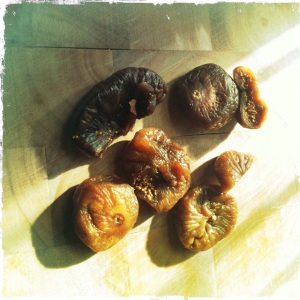Recipes
A recipe for fig butter
On our first menu we had a goat’s cheese sandwich with fig butter. It was my favourite sandwich. Truth be told, I’m not much of a sandwich eater, but to me the combination of jammy, winey fig with the ripe lactic squish of goat’s cheese was a winner. Not to anyone else, though: it was our most unpopular sandwich and so it disappeared from menu number two. But, like a cult movie, it had its fans. One sunlit afternoon I scribbled the recipe on some scrap paper for a lady who liked the fig butter so much, she wanted to know if we sold it. And recently, an artist exhibiting at the gallery came in after a few weeks away: I’d pushed my favourite sandwich on her the first time, only for it to be snatched away on the return visit. So, I promised I would publish it here for posterity.
And if you’re not one of the three people who already have a taste for fig butter? It might help to know that it’s good for more than just sandwiches. I took the recipe originally from an excellent book called Good To The Grain by Kim Boyce, which features wholegrain flours in lots of delicious guises (the beetroot quinoa pancakes are amazing, as are the rye crumble bars). There it featured in a recipe for a figgy buckwheat scone. The figgy buckwheat scone was good, but a bit much for some people to get their heads around (maybe the word scone was a problem, because it was swirl-shaped and faintly lavender-brown in colour). On occasion I would use the fig butter as the filling in a date and oat bar we sometimes bake, and that really took it to another level. You could also just use it as you would jam, on toast, or in a bowl of porridge. That would be perfect as the mornings get colder. Oh, and also one of our staff says that it “smells like Christmas”. So there you have it.
Fig Butter
This quantity will make around 4 cups, roughly 5 jars. It keeps in the fridge for 1 month, but halve the quantities if you won’t get through it (or give some away as presents).
1 cup sugar (caster, granulated or brown – all work)
4 cloves
2 star anise
480ml red wine
240ml port
680g dried figs
1/2 tsp cinnamon
240g butter (at room temperature)
Put half a cup of water and all of the sugar in a pan with the cloves and star anise and bring slowly to the boil, stirring to dissolve the sugar (if you do this too quickly, the sugar may crystallise). Once boiling, cook until it becomes an amber coloured caramel syrup – this will take at least 10 minutes. Keep an eye on it!
Add the red wine, port, figs and cinnamon. The syrup may seize and harden at this point, but don’t worry, it will come back together in the heat. Reduce the heat to a gentle simmer for at least 30 minutes, or until the liquid has reduced by half (chef tip: stand your wooden spoon straight up in the pan and mark where the liquid comes to initially with tape or just a mental note. Then you can use the same spoon to more accurately judge when the liquid is halfway reduced).
Shortly before the liquid is at the right point, sterilise your jars by either running them through the dishwasher, pouring some boiling water into them or washing them in hot water and then leaving them to dry in an oven on a low heat.
Fish out the cloves and star anise. Cube the soft butter and stir it in. Puree everything with a hand blender or in a food processor. Spoon it into the prepared jars. Make yourself a sandwich!
From ‘Good to the Grain: Baking with Whole Grain Flours’ by Kim Boyce, Stewart, Tabori & Chang, 2010

Discussion